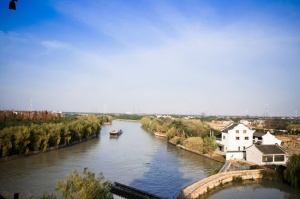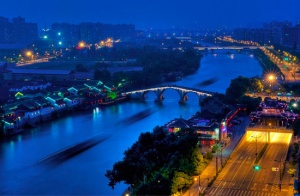Just recently, the Grand Canal in China, the world’s longest artificial waterway, made it onto the list of World Heritage Sites. CCTV News reporter Fei Ye talked to an expert about the significance of this title, and what the new responsibilities are that will come with it.
The Grand Canal has flowed for over 2,000 years before being inscribed as part of UNESCO’S newest World Heritage Sites on Sunday in Qatar. UNESCO described the Grand Canal as the world’s largest and most extensive civil engineering project, prior to the Industrial Revolution. So why did it take 8 years for such an important historical and cultural site to be listed?
“We started our pitching process to the World Heritage Committee in 2006, but the reason it took us so long to succeed is because we lacked basic research data on the Grand Canal. Since our modern environment changed so much, it was really difficult for our research team to identify historical remains along the canal.” said Zhang Jin, Deputy Director, Chinese Academy of Cultural Heritage.
The Grand Canal is a vast waterway system that runs from Beijing to Zhejiang province in the South. Constructed in sections from the 5th century B.C. onwards, it was conceived as a unified means of communication system for the country, transporting grain and strategic raw materials and supplying rice to feed the population. By the 13th century, it consisted of more than 2000 kilometers of artificial waterways, linking five major river basins in China.
“We are actually standing at the northest point of the Grand Canal. A lot of people don’t know that Shichahai is the terminal stop of the Canal. It might look ordinary but during the Yuan dynasty, this was a very popular place filled with boats and markets. The next step is to better educated our people about it.” said Zhang Jin, Deputy Director, Chinese Academy of Cultural Heritage.
Nations sometimes spend years developing their pitches to be able to qualify for the World Heritage List. UNESCO chose its sites based on its outstanding universal value and it must also meet one of 10 criterias.
Now that it is a world heritage site, what are the responsibilities for protecting the canal?
“Many city and provincial level preservation centers have already been developed. These centers will work closely with water conservation, transportation and environmental organizations to collect data and repair some of the rundown segments of the river.” said Zhang Jin, Deputy Director, Chinese Academy of Cultural Heritage.
But some residents are skeptical about the plans.
“The Grand Canal is such an important part of Chinese history. I’m thrilled that we are now part of the World Heritage List, but I don’t know how well preserving it will go.” said Sun Duobin, Beijing Resident.
“Being Chinese, I’m very proud of this news. The Grand Canal is as valuable as the Forbidden City or the Great Wall. The only thing that should be improved is its preservation. Some parts of it is already ruined.” said Ren Zhanhui, Beijing Resident.
The Grand Canal has been a vital organ of China’s economic prosperity, and it continues today as a major means of internal communication.
(http://www.cntvna.com/Culture/2014-07/31/cms165980article.shtml)




